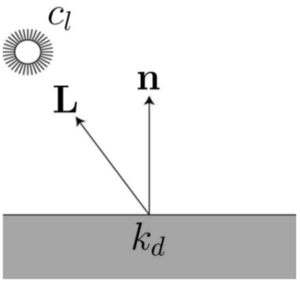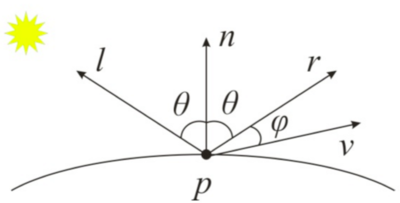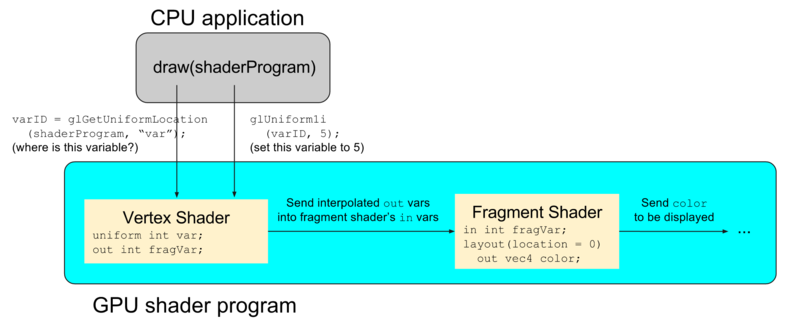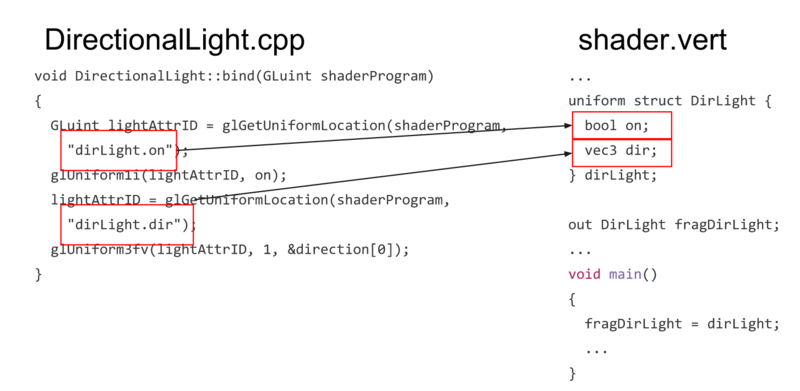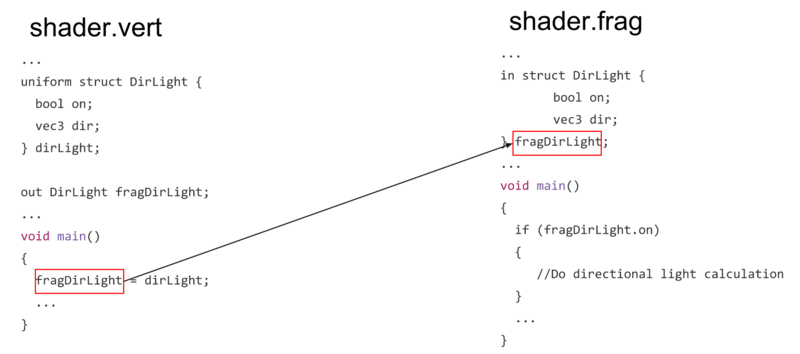Discussion4S16
Contents |
Overview
Week 4 discussion recap (04/18/16)
Slides: download here
Materials
Lights have material properties that define what kind of light they emit. Objects have materials that define how they'll react to these lights.
You can think of these properties as approximating the properties of a physical light's wavelength model and a material's reflectance model. If you want to learn more about physically accurate rendering techniques, CSE168 is your friend.
Ambient
The Ambient is used to define the "inherent color" of the object;this will be denoted as ka.
The light's ambient coefficient—denoted as La—is how much ambient influence the light emits. If this value is 1, the object's "inherent color" will shine through perfectly.
Diffuse
A Diffuse material is a material that reflects light rays in many directions(it "diffuses" the light);this is denoted with kd.
The light's diffuse coefficient—written as Ld—is how much of the color the light emits will be diffused.
Specular
A Specular material is to simulate the effect of shiny objects(such as in metals) creating a "spec" where the reflection direction and eye match up; this is written as ks.
Similar to the other light properties, the specular property of a light(Ls) is how much specular influence the light emits.
Shininess
The Shininess of an object is how much the specular is dispersed over the object. The higher this value, the smaller the highlight "spec". This is calculated through the exponent α.
There is no equivalent for lights.
Fiat Lux
Some Notation
Before we dive into the equations, lets take a look at a few notations.
- Component-wise multiplication (
∗)- In our equations as well as GLSL,
∗(astrisk) will do a component-wise multiplication. - Writing this out in code will look like:
vec3(a.x, a.y, a.z) * vec3(b.x, b.y, b.z)—which is equivalent tovec3(a.x * b.x, a.y * b.y, a.z * b.z)but more succint.
- In our equations as well as GLSL,
- Dot product (
dotor ⋅)- We should all be familiar with the vector dot product which takes two vectors and returns a scalar value. In GLSL, there is a built-in function
dot(v1, v2)that will perform this operation for us. - An example of this is
dot(vec3(1, 2, 3), vec3(1, -1, 0))which returns-1. - The dot product is often times referred to as the cosine factor, or treated it like it is equivalent to the cosine angle of two vectors. Can you figure out why? (Hint: Think about the law of cosine.)
- We should all be familiar with the vector dot product which takes two vectors and returns a scalar value. In GLSL, there is a built-in function
Some Common Values
Cosine Factor
The dot product between the normal and the light direction (n ⋅ l) is the main component that determines the diffuse brightness, and hence will be used in all of the following light equations. The below illustration shows what the n and l (big L in the image below) in regards to our surface and light.
How the light direction (l) is calculated will be different based on the type of light. Think carefully how you find your l!
Reflection Factor
Another dot product that will be important is the one between the reflected ray and eye direction (r ⋅ v). This is the factor that attenuates how much specular highlight we'll be seeing.
The reflected ray is easily calculated by using the GLSL reflect function. How does the math work? You should know this! It was in the Illumination Model lecture.
The eye direction (or the view vector) denotes the vector between the surface and the eye. How might we calculate this? Think back to how to find the vector between two points (the eye, and our current vertex position).
Back in the specular section, we mentioned how when the reflection direction and eye match up there'll be a highlight spec. Can you think of what would happen to the value of r ⋅ v when r and v are equal (i.e. they match up)? Does this make the highlight color brighter or darker?
Directional Lights
Directional lights will have on property in addition to the ones mentioned above in the Materials section.
- Direction (duh!)
Given the direction, how might you calculate light direction (l) for a directional light? Trick question! There is no calculation to be done as the light direction is simply the direction of the directional light. (You'll have to negate it to put it in the reference frame of our surface.)
So here it is! The grand equation for directional light calculations.
Point Lights
Similar to directional lights, point lights have a single attribute, its position (in addition to its emission properties of course).
- Position
How might we find the light direction l for a point light? It will have to be different from the directional light!
Remember that in Project 2, we require that you also implement attenuation for point lights, which is written as c in the equation below.
So below is the grand equation for point light calculations.
Spot Lights
The spot light is a deal more complicated than the two light types above. Here's the list of additional attributes we have to implement.
- Position
- Spot direction (spot_dir)
- Spot cutoff (θ; not in equation below)
- Spot exponent (spot_exp)
The spot cutoff is not expressed in the equation below as the cutoff check will be a separate if-statement check to make sure the surface we're calculating for falls under the spot light's cone. This will determine if we even care about the diffuse and specular component.
OpenGL Pipeline, Once More With Feeling
Why?
Remember how we discussed in week 3 that the modern OpenGL pipeline offers flexibility? Another thing it provides is also skipping the overhead of constant CPU to GPU communication.
Below is an illustration of the various functions and language supported keywords that let us transfer data without jumping back and forth between the CPU and GPU.
Once we've set this pipeline up, after glDrawElements is called, we never have to return back to the CPU until the GPU has finished blazingly quickly drawin the frame! We'll take a look at each section in detail.
CPU to GLSL
We've already learned one way to transfer data from the CPU to GLSL by means of VAOs in week 3's discussion. However, that was useful for passing in tons of vertex data that will differ per run of the vertex shader. What if all we want is a simpler data that will be uniform throughout our execution of the shaders?
This is where the uniform keyword comes in. If you declare a variable uniform in GLSL, it will be assigned an accessible location that we can store data to.
Where is my variable?
glGetUniformLocation(shaderProgram, variableName) returns a GLuint which is the location of where the variable is stored. This variable location can be used in the glUniform* functions to move data into the GPU.
Usage in Cube.cpp's draw method:
GLuint MatrixID = glGetUniformLocation(shaderProgram, "MVP");
How do I store things in them?
The suite of glUniform* functions help us send data from the CPU to the GPU. Below are some typically used examples.
-
glUniform1i(variableLocation, value): Used for passing in a single int value. This is extremely simple to use and we can just give it the uniform location ID and value. -
glUniform3fv(variableLocation, num, value): Used for passing in a vector of 3 floats. Thenumin the middle is how many vectors we want to pass in. This is usually 1, as we're passing in one vector at a time, unless we have an array of vectors we want to pass in. -
glUniformMatrix4fv(variableLocation, num, transpose, value): Used for passing in a whole 4 by 4 matrix. The only different syntax is thetransposeboolean value. This will usually beGL_FALSEin our case asglmalready uses column major, matching OpenGL's matrix storage scheme. SeeCube.cpp'sdrawmethod for an example.
You can view the full list and function signature in the OpenGL's glUniform* spec.
Vertex Shader to Fragment Shader
Attributes such as normals aren't uniform across a fragment shader. How do we pass on such variables from Vertex shader to fragment shader?
Again, the key is for us to not return to the CPU and cause overhead once the GPU has begun its work. The out and in keyword lets us send data from the vertex shader, down to the next shader that will run(usually the fragment shader).
A Direction Light Example
Let's say we're passing in a simplified directional light(it has two attributes, on and dir) from our application into the vertex shader, then to the fragment shader. This is very similar to what you will end up doing in project 2 part 4
We'd first pass in our directional light attributes into the uniform variables setup in the vertex shader. How might we do this? From the CPU to GLSL section, you can see that there are two steps:
- Find out the variable location using
glGetUniformLocation. - Set the variable with the appropriate
glUniform*.
You can see this implemented in the code snippet below.
Next, let's simply forward our directional light into the fragment shader, which will handle the actual per-pixel lighting calculations. This is done by declaring the same variable in each of the vertex and fragment shaders, as out and in respectively.
Of course, since all the vertex shader does is forward the directional light information to the fragment shader, we could've directly set the uniform variables of the fragment shader, but this was for demonstrating going through the whole pipeline. Certain attributes may actually come into the vertex shader, get transformed somehow, and then get passed along to the fragment shader. Can you think of any examples?
